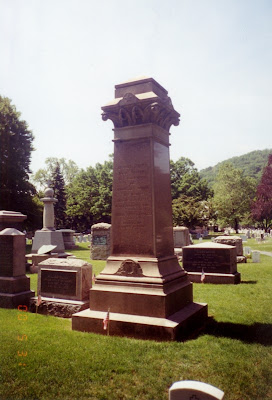Captain Oliver C. Bosbyshell wrote the following account of the 48th Pennsylvania's experience at 2nd Bull Run, August 29, 1862:
* * * * * * * * * *
Camp Forty-Eighth Regiment, P.V.,
Near Alexandria, Va., Sept. 3, 1862
A spare moment I devote to giving you a short account of the doings of the 48th in the late battles near Bull Run. I’ll not particularize about our long and tiresome march from Fredericksburg to Culpeper, &c, but suffice it to say, that we arrived on the Bull Run battlefield last Friday morning. Preparations were being made on every side for a fight, and we expected of course, to have a hand in it. We were not disappointed. Three o’clock Friday afternoon, Nagle’s Brigade drew up in line of battle—the 2nd Maryland on the right, next the 6th New Hampshire, and the 48th covering the latter regiment. Off we moved, over a clear field, to quite a dense wood, out of which we were to drive the rebels. The wood was skirted by a fence, which we had scarcely crossed—in fact, our regiment was just getting over it—when bang! bang! whiz! whiz! and the battle commenced. There was no use talking, however. Our Brigade went right in; walked steadily on, driving the rebels quickly before them, but losing men fast. A ditch or embankment, in which the rebels had shielded themselves, and from out of which the Brigade which entered the woods before ours failed to drive them, our Brigade assailed so fiercely, that it was soon cleared. The 48th had bayonets fixed. Some of the prisoners wanted to know who they were with fixed bayonets, and what troops we were. When informed, they said they thought we must belong to “Burnside’s fighting devils.”
The impetuosity of our men was great, and I believe we would have gone clear through the woods, without once halting, had not a strong flank movement been made by the rebels. They came around on our left, and opened a galling fire on our left flank and rear, which we did not return for some time, mistaking them for our own. When we discovered it, however, we answered lively, but they were too strong for us, with their raking cross-fire, and a retreat by the right flank was ordered. This we did in good order, returning fire for fire, and we got out in the clearing again, where the “rebs” dared not follow us.
It is difficult to note all the incidents of personal bravery. Colonel Nagle was everywhere, cheering on the men, and barely escaped capture. He was ordered to halt several times by the rebels, pursued and fired at, but escaped. Lieutenant John D. Bertolette, his acting assistant Adjutant General, our late adjutant, was wounded in the thigh, while ably attending his duties. His aides, Lt. Blake and Hinkle, were actively engaged throughout the entire fight. Upon entering the woods, Colonel Nagle and his staff left their horses at the fence, the woods being entirely too thick to ride through, and, in the flanking by the rebels, the horses were captured. The Brigade lost, in killed, wounded, and missing, some 530 men. The 48th behaved exceedingly well, and did considerable damage to the “Louisiana Tigers.” Lt. Col. Sigfried was in the thickest on the fray, encouraging the men by actions as well as words. He was ably seconded by Major Kauffman and Acting Adjutant Gowen. But I cannot particularize; all behaved well; no one shirked, neither officers or men.
Our loss is heavy, some 152 in killed, wounded and missing.
Nearly all the missing have been ascertained to be prisoners, and will be paroled and released shortly. Reno’s Division—our Brigade included, of course—was also in the action of Saturday protecting batteries, &c. Towards evening we were ordered into the woods, where we went, but the darkness ended the fight before we exchanged shots with the enemy. Our Division was exposed to the shells and shots of the enemy nearly all day Saturday—(none in the 48th hurt, two of Company H, taken prisoners)—and was the last Division to leave the field. We retired from the ground at 9 o’clock, and by five next morning were in Centreville. On Sunday we were picketed about two miles out of Centreville, and we met the 96th on our way out. Monday afternoon our Division started for Fairfax, and was the first Division engaged at the fight at Chantilly, where the gallant Kearney and Stevens fell. The Brigade lost a number killed and wounded again, but the 48th escaped with two men slightly wounded, merely grazed. We were posted in a wood on the right, to prevent any flank movement the enemy might make. We remained on the battlefield until 3 o’clock Tuesday morning, when we made for Fairfax, reaching it by sunrise. By 6 o’clock last night we reached our present quarters, almost fagged our with excessive marching and fatigue. The 50th, 96th, and 129th, are all near at hand.










 Orlando Willcox
Orlando Willcox James B. Ricketts
James B. Ricketts 

 Paul Joseph Revere
Paul Joseph Revere

